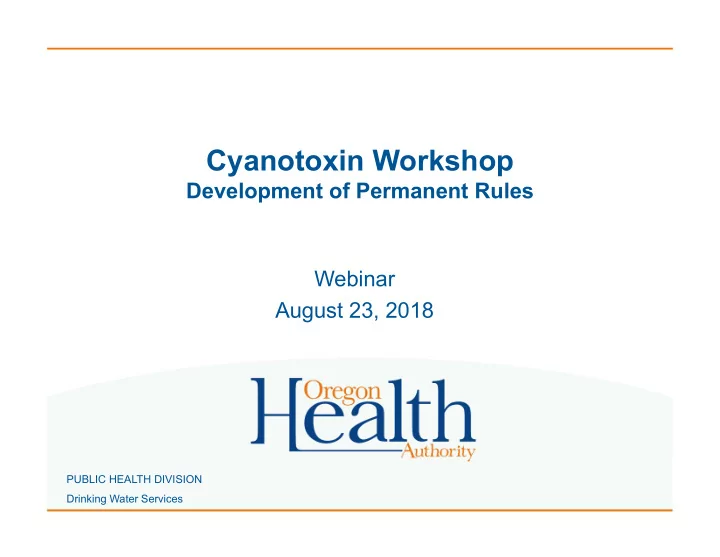

Cyanotoxin Workshop Development of Permanent Rules Webinar August 23, 2018 PUBLIC HEALTH DIVISION Drinking Water Services
Workshop Agenda • Welcome and Introduction • Analytical Methods – EPA and Ohio • Considerations for Permanent Rules: – Susceptibility criteria – Regulated cyanotoxins – Analytical methods – Use of screening method – Sampling frequency and triggers – Other topics • Next Steps PUBLIC HEALTH DIVISION Drinking Water Services 2
Overview • In June, the OHA director asked DWS to adopt regulations to ensure public health protection for cyanotoxins. • Emergency rules were adopted July 1, expiring at the end of 2018. Permanent rules must be adopted by January 1, 2019. • DWS is seeking common understanding and stakeholder input as we develop permanent rules. PUBLIC HEALTH DIVISION Drinking Water Services 3
Guest speakers Will Adams Analytical Chemist, Standards & Risk Management Division US Environmental Protection Agency Heather Raymond HAB Coordinator State of Ohio EPA PUBLIC HEALTH DIVISION Drinking Water Services 4
Risk and susceptibility criteria • 340 PWS treat or purchase surface water in OR • 230 surface water treatment plants • 100 of these sources met the susceptibility criteria established in emergency rules, requiring cyanotoxin monitoring: – HAB or toxin detected in past – Downstream of water body with HAB – Source does not meet DEQ water quality standards – Other, as determined by the Authority PUBLIC HEALTH DIVISION Drinking Water Services 5
Susceptibility criteria, cont’d • DEQ ambient water quality standards affecting cyanotoxins: – algae and aquatic weeds - ammonia – nitrates - sediment – chlorophyll-a - turbidity – phosphorus – pH – dissolved oxygen (May through October listings for cool and cold water); • Source characteristics: – slow moving or stagnant water, temperature, or available sources of nutrients PUBLIC HEALTH DIVISION Drinking Water Services 6
Susceptibility Criteria cont’d Rationale: • DEQ ambient water quality standards • Parameters indicate eutrophic conditions and high nutrient loads that can contribute to algae growth • Sediment and turbid water indicative of high phosphorus (a critical nutrient for algae growth). • Ammonia can indicate eutrophic conditions. • Clarified to exclude dissolved oxygen conditions that occur in the fall, winter, and early spring months when HABs usually do not occur. • Source Characteristics: • Temperature is added since warmer waterbodies can promote algae growth. PUBLIC HEALTH DIVISION Drinking Water Services 7
Susceptibility Criteria cont’d Impacts of proposed changes: • Sediment adds 5 new sources/systems • Turbidity adds 2 sources • Ammonia does not add any new systems • Cold- or cool-water aquatic life criteria for Dissolved Oxygen was already used in the previous selection of susceptible systems, just clarifying wording. • Discussion? PUBLIC HEALTH DIVISION Drinking Water Services 8
Regulated Cyanotoxins • Temporary Rules: Cyanotoxin For Vulnerable People For Age 6 and Above (ppb) (ppb) Total Microcystins 0.3 1.6 Cylindrospermopsin 0.7 3 • Proposed Permanent Rules: No change PUBLIC HEALTH DIVISION Drinking Water Services 9
Regulated Cyanotoxins - Rationale • EPA does not feel they have enough data in order to establish HALs for Anatoxin-a and Saxitoxin. Do we? • Ohio, Rhode Island, and Oregon established state HALs, but the OH and RI levels for anatoxin-a are an order of magnitude greater than Oregon’s levels, illustrating the need for a national standard. • Microcystin and cylindrospermopsin are the most common cyanotoxins found in recreational waters in Oregon • DWS may re-evaluate if EPA establishes additional HALs PUBLIC HEALTH DIVISION Drinking Water Services 10
Analytical Methods • Temporary rules requires only ELISA methods, including EPA Method 546. • Considerations for permanent rules: – EPA Method 546 for Microcystins – ELISA kit for Cylindrospermopsin; LC MS/MS (EPA Method 545) for confirmation sample in finished water • Discussion? PUBLIC HEALTH DIVISION Drinking Water Services 11
Screening for Cyanotoxins • Currently no screening, monitor cyanotoxins no less than every 2 weeks if susceptible • Considerations for qPCR: – Early warning of cyanotoxins – 3 to 4 hours analysis time – Cost savings – Conservative: if no genes, no toxin – No lab capacity in Oregon currently – New use of PCR: some unknowns – Complexity to implement PUBLIC HEALTH DIVISION Drinking Water Services 12
Sampling Frequency & Triggers • Temp rules, biweekly sampling of raw water, >0.3 ug/L triggers finished water sampling within 24 hrs • Considerations / Options: Tiered monitoring schedule based on risk/susceptibility – High risk systems have past raw water detections >0.3 ug/L and sample weekly – Low risk systems only sample if toxin is found in source water >1 ug/L. If source water is unmonitored, sample biweekly. – Criteria for increased and reduced monitoring – Triggers for finished water monitoring PUBLIC HEALTH DIVISION Drinking Water Services 13
Other topics? • Discussion PUBLIC HEALTH DIVISION Drinking Water Services 14
Next Steps • Draft rules will be sent to DWAC and stakeholders September 7, comments due September 25 • Final proposed rules by October 22 • Public hearing November 27 • All comments due November 30 • Final rules December 14 • Effective date: January 1, 2019 PUBLIC HEALTH DIVISION Drinking Water Services 15
Closing PUBLIC HEALTH DIVISION Drinking Water Services 16
Recommend
More recommend